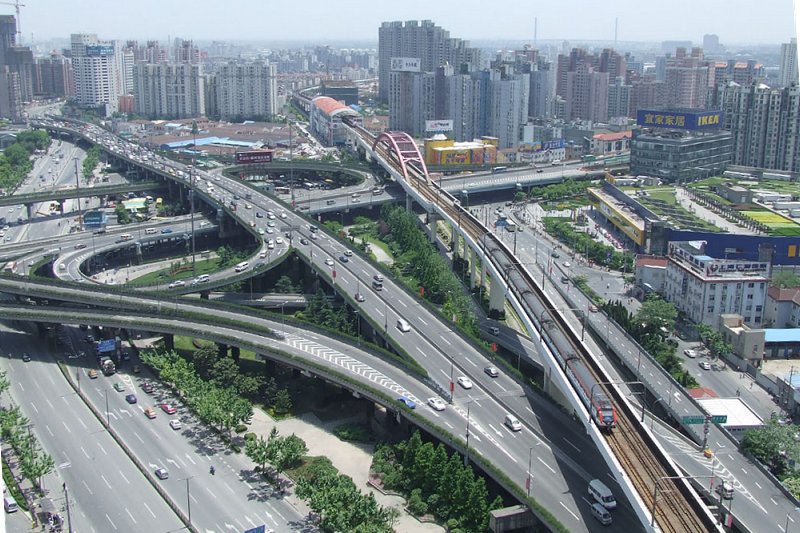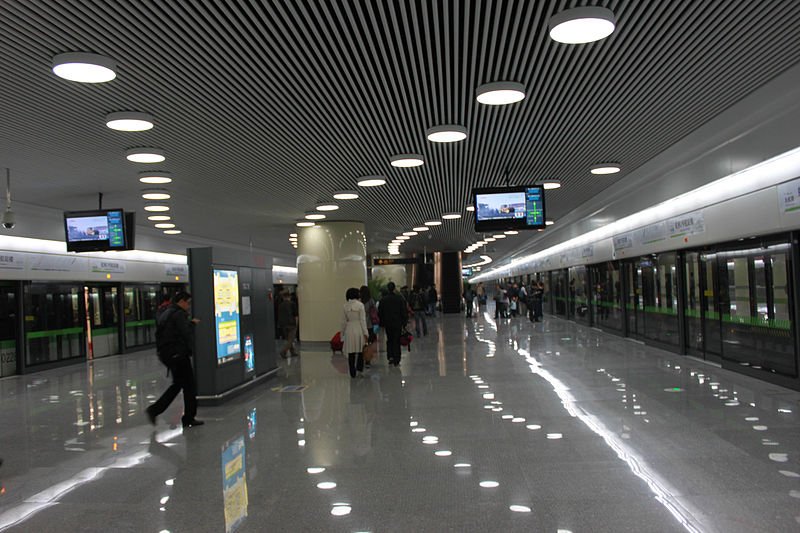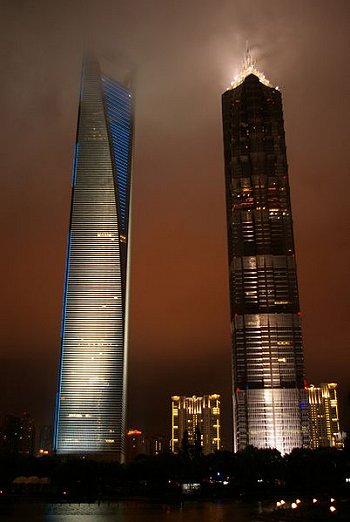 Pudong New Area, on the clear day
Pudong New Area, on the clear daySource: https://commons.wikimedia.org/wiki/File:Pudong,_August_2012_01.JPG
Author: Nicor

Shanghai is the most populous city in China. Comprising 16 districts and one county, it covers 6,340.5 sq km (2,448 sq mi) and has a population of 23 million people.
Shanghai is bordered by Jiangsu Province to the north and west, and by Zhejiang Province to the south. It faces the East China Sea to the east.
 Shanghai World Financial Center Observation Deck
Shanghai World Financial Center Observation Deck
Author: Nicor

Shanghai is the most populous city in China. Comprising 16 districts and one county, it covers 6,340.5 sq km (2,448 sq mi) and has a population of 23 million people.
Geography of Shanghai
Shanghai is located in the Yangtze River Delta. The municipality consists of the area between the Yangtze River and Hangzhou Bay. Also included within Shanghai is Chongming, the second largest island in mainland China, along with other smaller islands. Downtown Shanghai is not on the Yangtze River itself, but on the Huangpu, a tributary of the Yangtze.Shanghai is bordered by Jiangsu Province to the north and west, and by Zhejiang Province to the south. It faces the East China Sea to the east.
 Shanghai World Financial Center Observation Deck
Shanghai World Financial Center Observation DeckSource: https://commons.wikimedia.org/wiki/File:SWFC_Observation.jpg
Author: Alan Levine

 Shanghai Yangtze River Tunnel and Bridge
Shanghai Yangtze River Tunnel and Bridge
Author: Alan Levine

 Shanghai Yangtze River Tunnel and Bridge
Shanghai Yangtze River Tunnel and BridgeSource: https://commons.wikimedia.org/wiki/File:Shanghai_Yangtze_River_Tunnel_and_Bridge.jpg
Author: Max W

July is the hottest month in Shanghai, when the average high temperature rises to 31.8°C (89.2°F). January is the coldest month, with average low temperature of 1.1°C (34°F). June is the wettest month in the city, receiving 169.6 mm (6.67 in) of rainfall.
 Expressway interchange in Shanghai
Expressway interchange in Shanghai
Author: Max W

Climate of Shanghai
Shanghai experiences a humid subtropical climate with four distinct seasons. Summers are hot and humid while winters are cold and damp. The city is prone to typhoons in summer and at the beginning of autumn. Snow can be expected for one or two days of the year.July is the hottest month in Shanghai, when the average high temperature rises to 31.8°C (89.2°F). January is the coldest month, with average low temperature of 1.1°C (34°F). June is the wettest month in the city, receiving 169.6 mm (6.67 in) of rainfall.
 Expressway interchange in Shanghai
Expressway interchange in ShanghaiSource: https://commons.wikimedia.org/wiki/File:ShanghaiHighWayCXNR.jpg
Author: Pyzhou

The Huangpu River cuts Shanghai into two parts. Puxi, or West of the Huangpu River, is the older Shanghai, comprising eight districts. Pudong, or East of the Huangpu River, is the new Shanghai, comprising seven districts and one county.
 Shanghai Maglev train
Shanghai Maglev train
Author: Pyzhou

Administrative Divisions of Shanghai
Shanghai is divided into 17 county-level divisions, comprising 16 districts and one county. Each district has its own urban core, although downtown Shanghai is concentrated on the area bordered by the Bund to the east, Nanjing Road to the north, Old City Temple and Huaihai Road to the south.The Huangpu River cuts Shanghai into two parts. Puxi, or West of the Huangpu River, is the older Shanghai, comprising eight districts. Pudong, or East of the Huangpu River, is the new Shanghai, comprising seven districts and one county.
 Shanghai Maglev train
Shanghai Maglev trainSource: https://commons.wikimedia.org/wiki/File:Picture-4.jpg
Author: Andreas Krebs

 Shanghai Pudong International Airport Terminal 2
Shanghai Pudong International Airport Terminal 2
Author: Andreas Krebs

Arriving in Shanghai
The Shanghai Pudong International Airport (PVG) is the main international airport serving Shanghai. Located 40 km to the east of downtown Shanghai, it has two huge terminals connected by a free shuttle bus service. You can walk between terminals on a series of travelators. Shanghai Pudong International Airport Terminal 2
Shanghai Pudong International Airport Terminal 2Source: https://commons.wikimedia.org/wiki/File:Pudong_International_Airport_Terminal_2.jpg
Author: Baycrest

Hongqiao International Airport
The Shanghai Hongqiao International Airport (SHA) was the main airport of Shanghai before Pudong materialized. Today it is used mostly for domestic flights, though some shuttle flights for Tokyo-Haneda, Seoul-Gimpo, Hong Kong and Taipei-Songshan still departs from it. And it does have a shiny, new Terminal 2, used by all airlines. There is also the old, dingy Terminal 1, now delegated to serve low-cost carriers.
Terminal 2 is served by the Metro Line 2, which heads east to People's Square, then onwards to Pudong International Airport. The trains run daily from 5:35 am to 10:50 pm.
 Shanghai Metro Line 2 station at Hongqiao International Airport Terminal 2
Shanghai Metro Line 2 station at Hongqiao International Airport Terminal 2
Author: Baycrest

Hongqiao International Airport
The Shanghai Hongqiao International Airport (SHA) was the main airport of Shanghai before Pudong materialized. Today it is used mostly for domestic flights, though some shuttle flights for Tokyo-Haneda, Seoul-Gimpo, Hong Kong and Taipei-Songshan still departs from it. And it does have a shiny, new Terminal 2, used by all airlines. There is also the old, dingy Terminal 1, now delegated to serve low-cost carriers.
Terminal 2 is served by the Metro Line 2, which heads east to People's Square, then onwards to Pudong International Airport. The trains run daily from 5:35 am to 10:50 pm.
 Shanghai Metro Line 2 station at Hongqiao International Airport Terminal 2
Shanghai Metro Line 2 station at Hongqiao International Airport Terminal 2Source: https://commons.wikimedia.org/wiki/File:%E8%99%B9%E6%A1%A5%E4%BA%8C%E5%8F%B7%E8%88%AA%E7%AB%99%E6%A5%BC%E7%AB%99.JPG
Author: Jucember

Looking for information on Penang? Use this Map of Roads in Penang to zoom in on information about Penang, brought to you road by road.

Author: Jucember

Places of Interest in Shanghai
- French Concession
Once a foreigner's enclave, today the French Concession is an upscale residential and retail neighborhood. - Fuxing Park
Park located within the French Concession still bearing elements of French garden style. - Hongkong and Shanghai Bank Building
Historic building on the Bund, today housing the Shanghai Pudong Development Bank. - Hongkou Park
Park with lake to the north of Suzhou Creek, where the locals go for boat rides. - Huangpu River
Famous river that flows through Shanghai. - Jade Buddha Temple
Also known as the Shanghai Yufo Temple, this is one of the most famous Buddhist temples in Shanghai. - Jin Mao Tower
This is one of the first major skyscrapers in the Pudong district of Shanghai. - Jing'an Temple
An important temple with a history going back to the 3rd century AD. - Longhua Cemetery of Martyrs
Cemetery of those who died to advance the communist caused, located where the Nationalist executed hundreds of Communists. - Nanjing Road
The most famous road in Shanghai, major location for the biggest department stores of the city. - Old Bank of China Building
Heritage building on the Bund. - Oriental Pearl Tower
An observation and telecommunication tower in Pudong district with a dramatic design. - Peace Hotel
Famous historic hotel on the Bund. - People's Park & Square
Famous public square in the heart of Shanghai. - Pudong
New development precinct of Shanghai, and home to its tallest skyscrapers. - Shanghai Art Museum
Museum housed in the former clubhouse of the Shanghai Racing Club. - Shanghai Exhibition Centre
Grim, Soviet-style structure erected in 1954. - Shanghai Grand Theatre
A mammoth theater designed by a French architect. - Shanghai Museum
Huge museum housing over 120,000 artifacts. - Shanghai Urban Planning Exhibition Hall
Six storey complex showcasing the urban development of Shanghai. - Shanghai World Financial Center
Momentarily the tallest skyscraper in Shanghai. - Site of the First National Congress of the Chinese Communist Party
Historic house within the French Concession. - Song Qingling's Former Residence
Former residence of the wife of Dr Sun Yat-sen. - The Bund
Famous riverside promenade in Shanghai. - Xujiahui Catholic Cathedral
Gothic-style Roman Catholic Cathedral of St Ignatius. - Yuyuan Garden
Garden next to the ancient city park of Shanghai.
Sights in the vicinity of Shanghai
- She Shan
Hill to the southwest of Shanghai. - Song Jiang
Charming little town between Shanghai and Hangzhou.
 Latest updates on Penang Travel Tips
Latest updates on Penang Travel Tips
 Map of Roads in Penang
Map of Roads in Penang
Looking for information on Penang? Use this Map of Roads in Penang to zoom in on information about Penang, brought to you road by road.
Copyright © 2003-2025 Timothy Tye. All Rights Reserved.

 Go Back
Go Back Shanghai at dusk
Shanghai at dusk A lilong in Shanxi Nan Lu, Shanghai
A lilong in Shanxi Nan Lu, Shanghai Shanghai World Financial Center and Jin Mao Tower
Shanghai World Financial Center and Jin Mao Tower